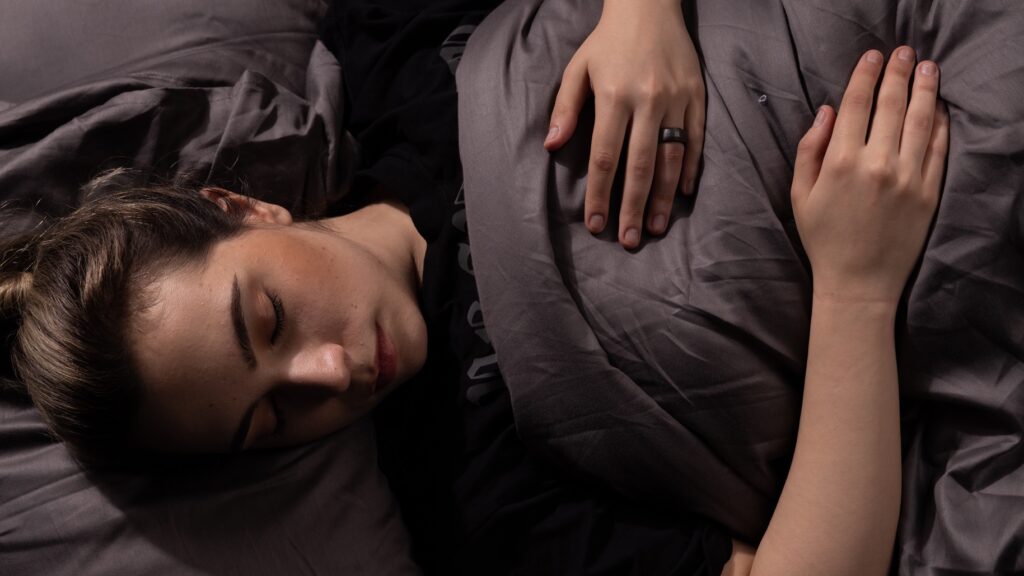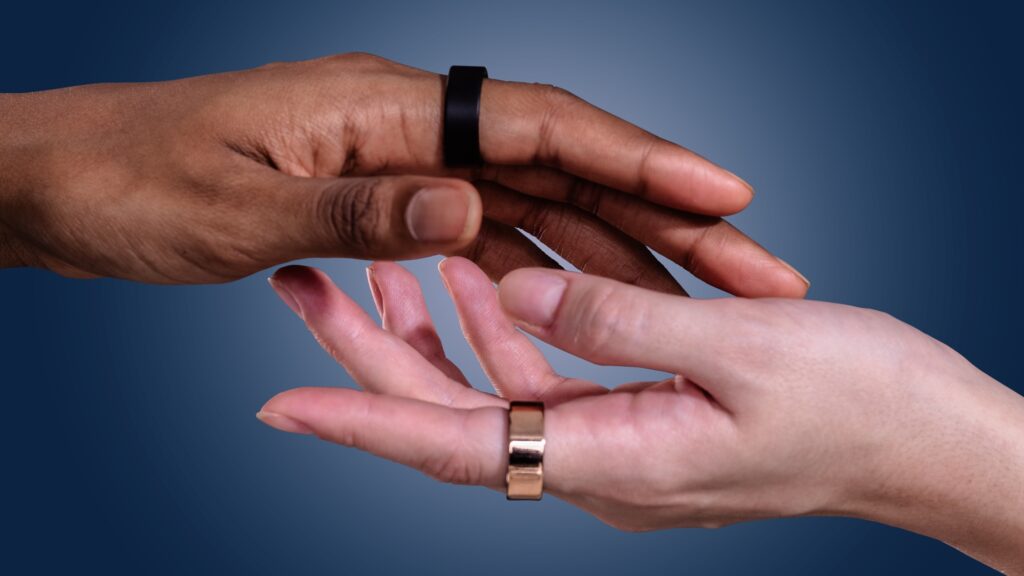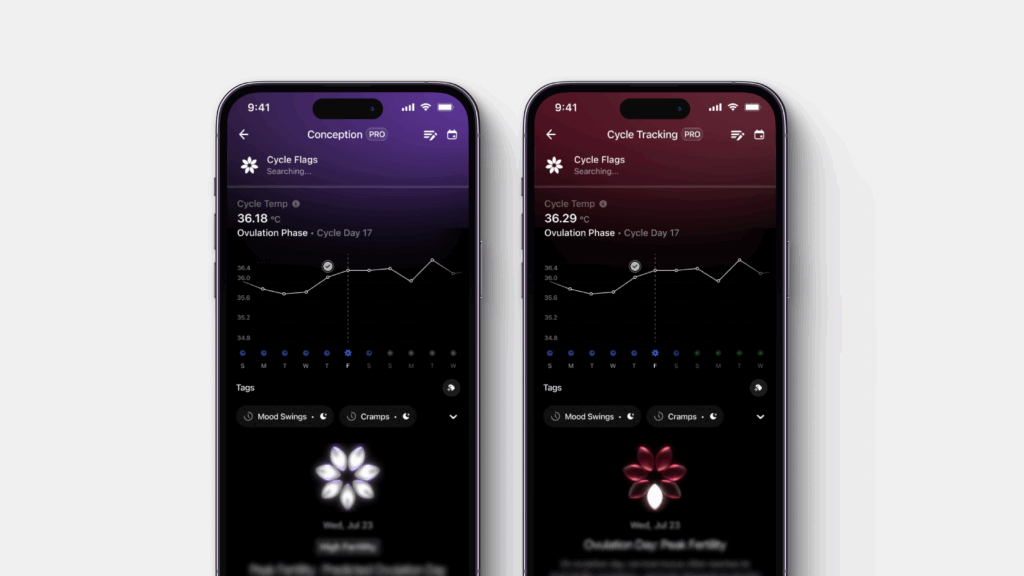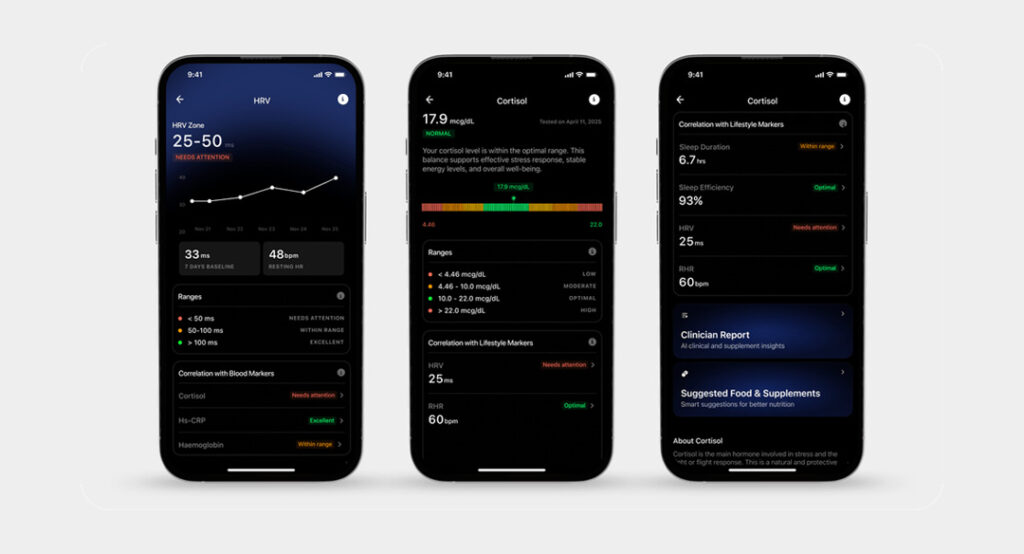Skin temperature is a key biomarker that fluctuates based on circadian rhythms, hormonal changes, and overall physiological health. It’s a core signal and a window into sleep, recovery, wellness, and illness.
The Ultrahuman Ring AIR tracks skin temperature during sleep and compares it to established individual baselines to help users understand their body.
In this article, we’ll explore how skin temperature tracking works on the Ultrahuman Ring AIR, what the data reveals, and how to use these insights to optimize recovery and well-being.
Read next: The factors influencing skin temperature explained
How the Ultrahuman Ring AIR uses temperature data
The Ultrahuman Ring AIR monitors skin temperature continuously, capturing fluctuations and deviations from your baseline.
Nightly skin temperature fluctuations are natural. They are driven by the circadian rhythm and rise and fall as we sleep. But shifts may also reflect stress, illness, recovery, and crucially, the menstrual cycle.
For menstrual cycles, the ring detects ovulatory patterns and menstrual phase changes via skin temperature, offering insights for period prediction and reproductive health.
Features that use skin temperature data

- Recovery Score: Temperature changes reflect recovery, and it’s a key metric of the Ultrahuman Dynamic Recovery Score. It recognizes your body’s state of recovery by analyzing your sleep, heart rate (HR), heart rate variability (HRV), and temperature. A higher skin temperature during sleep suggests that your body hasn’t recovered well.
- Cycle and Ovulation: The Power Plug determines a 7-day fertile window, pinpointing ovulation day using real-time data from biomarkers like skin temperature, HRV, and RHR using the Ring AIR. These patterns help estimate fertile days before ovulation. Unlike traditional methods, this PowerPlug provides proactive, accurate, and seamless fertility insights.
- Circadian Alignment: By analyzing your sleep temperature minima, the Circadian Alignment Power Plug optimises your sleep-wake cycle to enhance cognitive function, energy levels, and hormone balance.
Causes of skin temperature deviations explained

1. Monitor stress and recovery
The Ultrahuman Ring AIR tracks skin temperature overnight – a window where stress-related changes are most detectable. Elevated nighttime temperature can reflect immune activation or poor recovery, while a steady or dropping temperature may indicate adaptation and resilience
Consistently elevated nighttime skin temperature may point to accumulated stress, poor recovery from training, or early illness. Pair this with HRV and sleep data for context.
A stable or decreasing overnight temperature, especially after hard training, suggests your body is recovering well.
Look out for:
If recovery scores are down and skin temperature is trending up, prioritise sleep, lower intensity, and stress management techniques (e.g. breathwork, reduced caffeine, light exposure in the morning).
2. Boost sleep quality

Your circadian rhythm drives a natural rise in skin temperature at night – a key sleep initiation signal. The Ring AIR tracks these shifts and highlights irregularities that could be disrupting sleep quality. Flattened or inconsistent skin temperature patterns may suggest misaligned circadian rhythm or disturbed sleep.
Sharp fluctuations overnight could indicate poor sleep hygiene, inconsistent routines, or environmental disturbances (e.g. temperature, light).
Look out for:
If skin temp data shows erratic trends, try anchoring your schedule with consistent bed/wake times, cooling you room as much as possible, limiting late screen use, and supporting nighttime heat dissipation (e.g. warm socks or take a bath before bed).
3. Detect early signs of illness
One of the most actionable uses of skin temperature data is early illness detection. The Ultrahuman Ring AIR can identify subtle nighttime temperature rises before core body temperature spikes, often hours ahead of symptom onset.
A sustained rise from your baseline, not explained by cycle phase, training, or environment, may signal an early immune response. This often correlates with lower HRV, disturbed sleep, and fatigue.
Look out for:
If you notice a sudden rise in skin temperature alongside poor recovery or reduced HRV, scale back intensity, prioritise rest, and hydrate proactively. You may be fighting something off before symptoms appear.
4. Be aware of your menstrual cyle
For users tracking their cycle, skin temperature offers a non-invasive view into ovulation and hormonal shifts. The Ultrahuman Ring AIR and the Cycle and Ovulation PowerPlug detects post-ovulation rises linked to progesterone and tracks luteal phase patterns over time.
Look out for:
Skin temperature fluctuates during the cycle. Being aware of these fluctuations can put you in tune with your body, and you can boost sleep by taking steps to cool your room or wear lighter clothes to bed, when your body temperature rises in the ovulation and luteal phases.
Menstrual Phase (Typically Day 1): As hormone levels drop significantly, both skin temperature and RHR decrease, signaling the start of your period.
Ovulation (Approximately Day 14): As estrogen peaks, biomarkers start to shift. Skin temperature rises slightly due to increased progesterone.
Luteal Phase (Typically Days 15–28): After ovulation, progesterone increases, which results in higher skin temperature (around 0.5°C). You might notice your body feels warmer. However, HRV tends to drop, indicating more stress on the body..
Read our guide to the four stages of the menstrual cycle and how they could make you feel.
Conclusion
Skin temperature is a key indicator of sleep quality, stress, metabolism, and hormonal balance. Continuous tracking with the Ultrahuman Ring AIR enables users to spot trends, catch issues early, and take proactive steps to improve health and performance.








